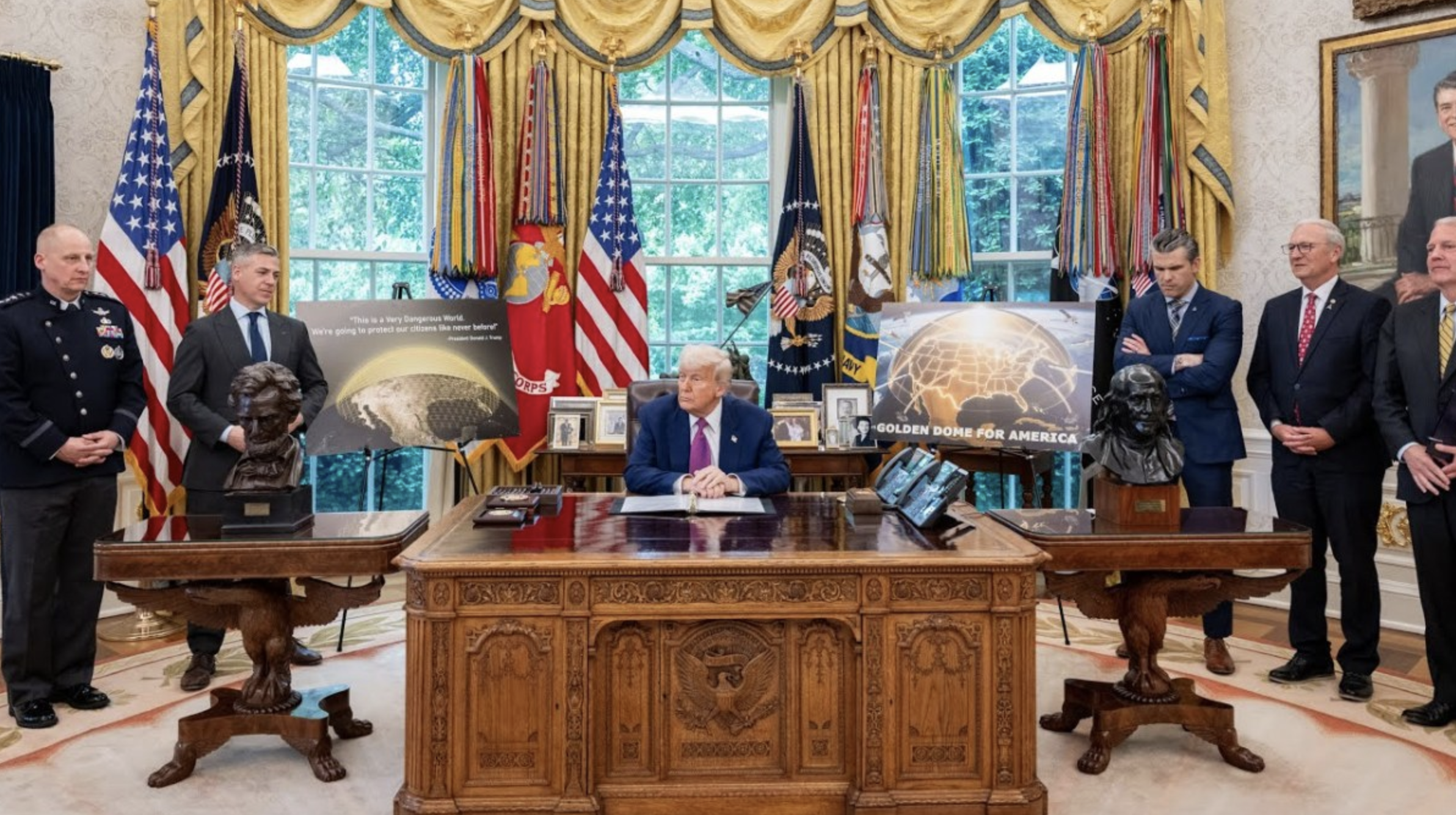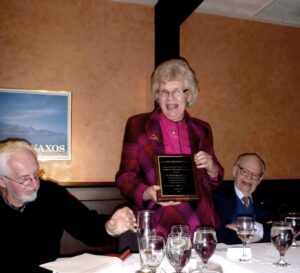This article was originally published in Policy journal.
Prof. Peter Jones and Policy: Canadian Politics and Public Policy have kindly allowed us to repost this commentary here.

Donald Trump unveils proposed Golden Dome missile defence system, May 20, 2025/WH image
By Peter Jones
May 25, 2025
President Trump’s determination to build the so-called “Golden Dome” missile defence system raises fundamental questions for Canada. Should we participate or not? What consequences will a decision, either way, have for existing Canada-US defence relations, most notably NORAD (North American Aerospace Defence Command)? What consequences will it raise for Prime Minister Mark Carney’s stated desire to diversify away from our asymmetrical relationship with the US? These are not small issues.
Lost in the public discussion, thus far, is a nuanced appreciation of two facts: first, the Golden Dome is far from a certainty (indeed, detailed plans as to how it will work do not seem to exist yet, ditto for some of the technologies that will be crucial to its success.); and second, “participation” in this venture can take many forms.
Logically speaking, full participation would imply that Canadian military personnel would serve in the command and control of whatever system is eventually built, and we would share in the extraordinary costs of building and running it. But there may be more limited options. The way the issue was dealt with the last time it came up is instructive.
During the presidency of George W. Bush, the US decided to build a limited missile defence system. Bush wanted Canada to participate. Ultimately, Prime Minister Paul Martin decided not to, for a variety of political reasons. This decision raised issues. Canada very much wanted NORAD, the binational command that provides early warning and tracking of aerospace threats to North America, to continue. NORAD provides Canada with coverage of its territory at a fraction of the cost it would take us to do this by ourselves.
Significantly, NORAD implicitly achieves a measure of US recognition of our sovereignty in the North, for aerospace defence purposes at least, by establishing that the US NORAD presence there is part of a treaty-level arrangement that defines the territory as Canadian. This does not entirely solve the sovereignty problem, but it is better than nothing.
By opting out of participation in the Martin era, we faced a situation whereby the US would simply go its own way to develop the threat warning and tracking system on which that missile defence would rely. This would have eventually rendered NORAD obsolete. What we did in the Bush-Martin era was to square the circle.
We declined to participate in the missile defence system, but we agreed that NORAD should provide its early warning and threat tracking component. In effect, NORAD identifies and tracks incoming threats and Canadians are part of that process; but then the actual missile defence system takes over to try to engage those threats and Canadians are not part of that. We have long sought to thread the needle between detection and interception.
Fast-forward to President Trump’s Golden Dome and we face similar issues. Can we maintain NORAD’s benefits to Canada by finding a way to allow a modernized and more capable NORAD to provide the new system’s early warning and threat tracking capability, but not be part of the interception of the incoming missiles?
As we don’t yet know the details of the Golden Dome system, it is hard to say. For example, the architecture of President Bush’s more limited National Missile Defense (NMD) of several decades ago worked with all of the interceptor missiles based on US territory. Will that be the case today, or will the architecture of the Golden Dome require some of the interceptor missiles to be based in Canada, as well as in the US and in space? It is not yet clear, but, if some interceptor missiles have to be based in Canada for the system to work, a decision will have to be made to participate or not.
Moreover, the missile threat has evolved. Much more capable, long-range cruise missiles now pose a significant threat. Geography dictates that, even if their targets are in the US, they will fly over Canada. The US will never allow this threat to go unmet. If we don’t meet it, or cooperate with them to do so, they will meet it on their own and they won’t ask our permission.
Could Canada play a role in intercepting cruise missiles, but not in intercepting ballistic missiles? Can the two threats be separated from each other? If North America ever came under concerted attack, a potential enemy could launch both kinds of missiles to try to overcome defences. Can one have two entirely different command systems, one for cruise missiles and one for ballistic missiles, if those missiles are acting in concert?
These are some of the issues Canadian officials are likely grappling with. They need to figure out what is vital for Canada to participate in for our own interests, and what could be left to the US alone without threatening our sovereignty. And they need to do this in the overall context of a wider Canada-US relationship that has gone from stable over many decades to more hostile, uncharted territory that is inherently unpredictable.
We do have control over the question of whether and how we ‘participate’, and we should not assume that ‘participation’ in the system is necessarily an all-or-nothing affair.
This last point is especially crucial. President Trump’s fascination with the Golden Dome may be this week’s plaything, or it may be a lasting policy. His methods of achieving it may, or may not, hew to political and diplomatic norms with respect to things like our sovereignty — which he has already questioned anyway. When the costs of the system mount, as they are expected to do quite spectacularly, much of it may be quietly “postponed”, particularly if his tariff and other economic policies lead to a deep recession and the US cannot borrow on the bond markets to finance its endless debt.
Much of the project may prove a chimera in the end. Any real estate developer trying to sell the promise of a “big, beautiful building” to come (someday, if the land can be acquired, and the regulatory barriers overcome, and the money can be found at the right rates), will always try to make a hard sell to investors before ground is broken.
Of course, there are wider issues. Will the Golden Dome actually work perfectly, as the Trump administration says it will, and be operational before he leaves office in three years, as he says it will? Most experts think not. Will it stimulate a new arms race as Russia and China seek to overcome this new defence by building more missiles? Most experts think it will.
And, if we opt to fully participate in the system, and parts of it are eventually based in space (as preliminary designs call for), will participation mean abandoning our long-standing, treaty-based, opposition to weapons in space? What will other countries, those with whom we hope to diversify our relations, think of that? If we go all-in on this system, can we still diversify defence relations more broadly?
These higher-order questions are serious, though some of them are probably ones over which Canada doesn’t have much control. But we do have control over the question of whether and how we “participate,” and we should not assume that “participation” in the system is necessarily an all-or-nothing affair. Nor should we assume that the system Trump imagines in his frequently changing mind is the one that will ultimately be built in the decades to come.
Depending on how it is designed, participation could take the form of doing largely what we do in NORAD today — provide early warning and tracking of incoming threats. Or it could require a much deeper and more active level of engagement. Until we know where all of this is going, maybe the protection of the NORAD mission, and its benefits to Canada, is the prudent play.
If, under a different president in a future time, once the system is more fully understood and the Oval Office is a more stable place, Canada’s interests will be served by a more fulsome participation that can be revisited. President Trump may decry this approach as insufficient, but we have something he needs; our geography. As senior US military personnel have made clear before Congress, the system’s early warning requirements cannot be met without Canadian participation.
Defence experts and contractors who support such participation will be looking to get in on the ground floor, and will no doubt say that a firm decision about full membership is required today; that decisions are being made now as to what the system will look like and we need to be inside the room if we are to be full players. Some may also quietly argue that whether or not the system works someday in the future is not the main issue right now; we need to show the US that Canada is a serious ally on defence and signing up for this signature project will do that. Perhaps.
But this is tantamount to signing up for a decades-long project which will cost hundreds of billions of dollars without really knowing whether it will work or what our ultimate role will be in whatever is finally produced, if the system is ultimately built at all. It requires a leap of faith to imagine today that our defence interests will always be absolutely congruent with those of the US and that it is a prudent decision to commit to this now, when so much about our relationship with the Americans is so uncertain. As Prime Minister Carney has said, America under Donald Trump is not the reliable ally it once was.
If the decision is made to pursue an alternative to immediate full participation in the Golden Dome, finding a way to gently sell this will not be easy. In the context of broader discussions over tariffs and future economic and security arrangements, Canada’s representatives will have to tiptoe carefully around the issues. As is so often the case in diplomacy, the question is not whether you say “yes,” or “no,” but how you say it; which doors you close and which ones you leave partially open for another day.
Whichever way we go, it is crucially important that we be deadly serious about getting to 2% of GDP for defence quickly, or even beyond 2%. A failure to join the Golden Dome wholeheartedly, if coupled with an ongoing failure to meet this NATO spending commitment would be fatal to any credibility we might have. As part of that, the ongoing costs of modernizing NORAD, which will not be insignificant, cannot be skimped on.
If we are going to make our willingness to see NORAD play the role of threat detection and tracking the cornerstone of our approach to the Golden Dome, an approach that lands at “slightly less than full participation, but not quite rejection either,” we have to show that we are fully committed to doing an outstanding job on the NORAD mission.
Peter Jones is a Professor in the Graduate School of Public and International Affairs at the University of Ottawa.



 May 8, 2025 – Canadians for a Nuclear Weapons Convention (CNWC) is pleased to announce its new name: Canadian Leadership for Nuclear Disarmament (CLND). This change is to enable the organization’s name to better describe the breadth of the work we have done and will continue to do.
May 8, 2025 – Canadians for a Nuclear Weapons Convention (CNWC) is pleased to announce its new name: Canadian Leadership for Nuclear Disarmament (CLND). This change is to enable the organization’s name to better describe the breadth of the work we have done and will continue to do. Michael Manulak is a member of Canadian Pugwash Group.
Michael Manulak is a member of Canadian Pugwash Group.